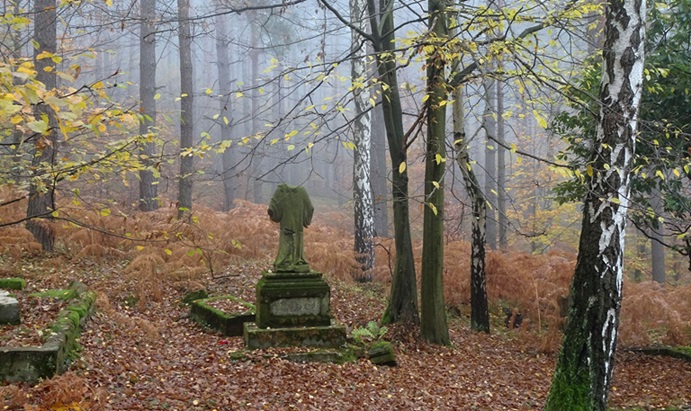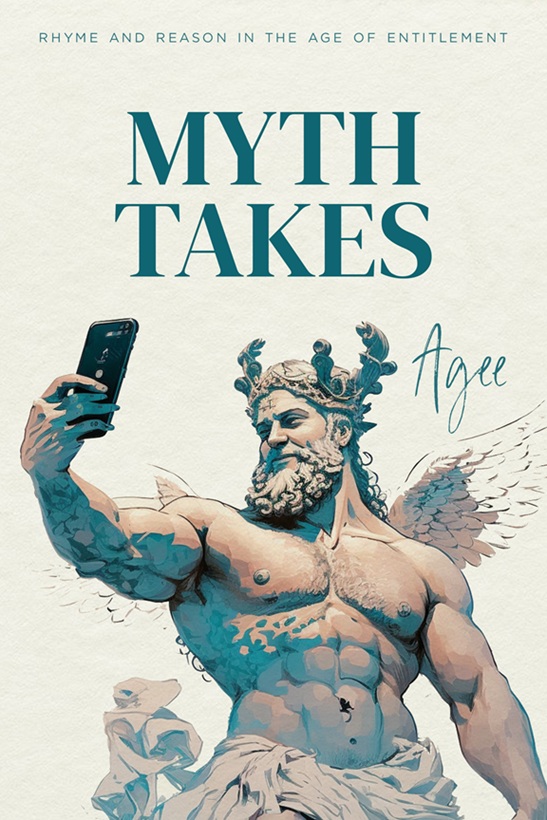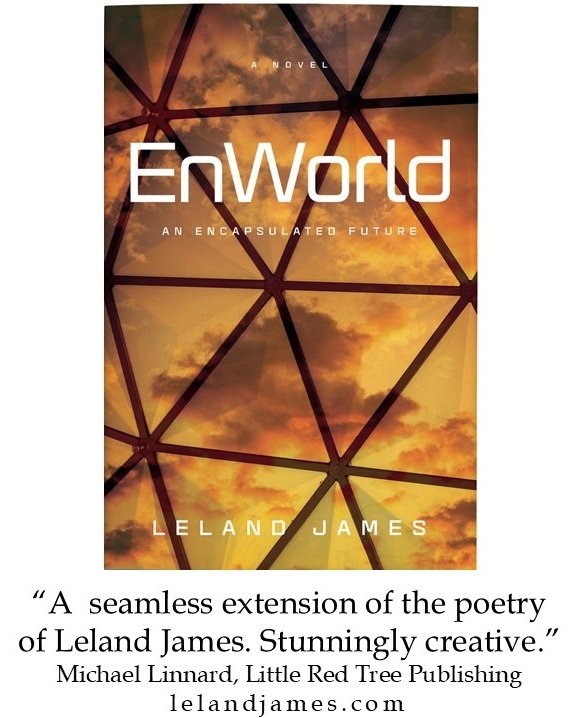.
An Abandoned Cemetery
Pines thinly hid them on the forest floor:
huge, useless molars, only three or four
upright—a sign remembrance, too, had died.
He climbed the rusted gate and jumped inside.
Thick, unpruned brush could mask but not deny
these double deaths. But leaf-flecked morning sky
gave him the swishing courage to trespass
through goldenrod ablaze in autumn grass
against the ghosts. Black slates, slumped and abraded,
rebuffed demands to be interrogated,
their dates and names erased like blackboard chalk.
What more to see? This: shuffling on his walk
his shoe scuffed whiteness half-concealed in earth,
two years inscribed, the same for death and birth,
with chiseled letters brimmed with gritty moss
beneath two scrolling wings and a small cross
—a simple child’s slab laid without a stand.
He wiped leaves off the tablet with his hand,
scrubbed moss with his shirtsleeve and spoke the words:
“Ann, gone to play with angels.” Cheerful birds
nearby evoked a girl’s angelic play,
or did they tease him why he played today
with stones where even ghosts refused to stay?
A bell chimed. Late for school, he ran away.
.
.
Carey Jobe is a retired attorney. In addition to the Society of Classical Poets, his poems have recently appeared in Blue Unicorn, The Orchards Poetry Journal, The Road Not Taken, and The Chained Muse. He lives and writes near Tallahassee, Florida.
















I absolutely LOVE this poem, Carey!
I feel as if I’m there!
I’ve made several oil paintings in cemetery settings, so this one was going to be up my alley in any case, but your execution is immaculate!
Thanks, Paul! I’m glad my poem could pass muster with an accomplished painter.
I completely agree with Paul’s comment. Although I’ve never trodden a cemetery, reading this poem took me to that setting. I was struck by the line ‘two years inscribed, the same for death and birth’. It’s a beautiful poem that is loaded with imagery, saddens the heart, and manages to stretch one’s lips towards the end. Thank you for this, Carey!
Thanks, Shamik!
I have visited abandoned cemeteries on occasion on farms, ranches, and plantations. They have always been intriguing to me. Your exquisite poem with a wonderful choice of rhyming words recalled my own feelings of reverence and curiosity. The sadness and beauty of finding the gravestone of a baby with such sweet words inscribed touched me. The last line was inspired as the presumable youth heard a bell chime and ran off to school.
Roy, thank you for taking the time to comment. I am very glad my poem could touch you in this way. Best wishes for 2024.
Cemeteries have an odd feel to them, don’t they? It has been years but I am still wondering why the local witch rushed home to call my mother to tell her I had been seen Prone on a flat stone kissing a boy. Come to think of it, what was the witch doing there anyway?
You have captured that feel.
Thank you, Sally. As for the witch, serendipitous jealousy perhaps?
Carey, Your poem recalls a personal memory of walking through an old, neglected sugarcane plantation cemetery on North Shore Oahu. Among the stones I counted seven which marked graves of young children who had died within months of each other embracing the final months of 1918 and the first months of 1919–dates that represent the height of the the year of the Great Influenza epidemic that took the lives of + or – 50 million people worldwide.
No doubt there were other children and adults lost in that small community.
Your poem well captured the feelings associated with the unexpected encounter with such distant, forgotten grief.
Thank you for sharing that story, James. The Hawaii plantation you visited sounds similar to the old plantation cemeteries that still exist in this section of Florida. What poignant tales lie hidden beneath those stones! I’m glad my poem could evoke those heartfelt memories.
There’s a ton of craft to love in this poem.
First, I love the choice of heroic couplets. It just sets the right tone and frame for the venture that is this poem. The closure or pauses that play through the first eight lines convey the ultimate of all closures in a shadowy way. Then, the enjambment between S2 and S3 is killer! There’s well-timed pause between stanzas to take a half-way frightened breath, then the surprise entry of ghosts.
And the whole poem turns from investigating things to investigating people. And the depth of haunted-ness just opens up before the reader-now-fellow-journeyer.
The motion is maintained by the couplets and the exploration and discovery comes out with just the right timing. Another enjambment between stanzas conveys the feeling of the protagonist’s foot hovering for a moment before scraping the stone, which you wisely do not break pace to reveal. Another enjambed stanza fitting the pause in thought as we, the readers, figure out, at the same pace as the protagonist, what’s going on. We are firmly IN the poem.
I have not encountered poems of children discovering and musing on children, but for sure that happens in real life. I’ve had some moments like these when I was nine (and a pallbearer for my great-aunt’s funeral). So, the mention of a child inclines the reader (adult) to be an adult, and another well-honed surprise greets us: it’s a child here. And the child in us is reached.
Final, super-cool touches of the same rhyme on all four of the final lines. And an “AY” rhyme. When, in the last line, we read about the bell, we realize we too have been hearing it for a bit — that’s the power of those four rhymes played as they have been. Super-cool. A great closure device on multiple levels.
Sneaking the word, “late” in there was also a clever touch.
Many, many things to thoroughly enjoy about this poem.
Daniel, I’m deeply honored that you made such a detailed and thoughful exposition of my poem. Poets who consider their poems a formed work of art, and who value poetry’s traditional techniques, sometimes wonder if their craft is noticed by readers. Thanks to you, and the other kind members of this forum who commented, I can rest easy on that score. I’m vastly grateful! Thank you, and have a wonderful New Year. Carey
Daniel, this comment deserves a top grade, or maybe a prize.
Wow!
My fave line and a bit, amongst many fine lines, is:
“Thick, unpruned brush could mask but not deny
these double deaths.”
Thanks for a vivid, memorable poem, Carey.
Thanks for commenting, Paul. I’m glad you liked my poem.
This is truly beautiful description, with poignant, palpable overtones. Thank you, Carey.
Thank you, Cynthia! My earlier thank you was posted out of sequence, sorry!
This is an excellent poem, both beautiful and haunting. The description of the little girl’s tombstone slab is filled with pathos, and as Daniel Kemper has pointed out above, the verbal and metrical intricacy of the poem is utterly dazzling.
There is a very small colonial graveyard still surviving in Woodside, where I grew up. One can still see a standing gravestone, marked “A.M. 1769.” Since this is known as the Moore-Jackson graveyard, the grave must be the resting place of someone with the name Moore, and the neighborhood of “Jackson Heights” is right next to Woodside.
Sometimes we forget how close the past is to us.
Joe, thank you for commenting on my poem and for sharing the story about the graveyard. Here in the South there are many abandoned graveyards from pioneer days that were abandoned when the families died out or moved on. They convey a sense of being orphaned and always remind me how important it is that the living remember the dead. For so many cultures, remembrance of ancestors is an important duty of the living. All that played a role in the poem. I’m really glad you liked it. Happy New Year!
Thank you, Cynthia. Glad you liked it!
Carey, this poem is breathtaking – in its craft and its content. It is written so smoothly and eloquently; it is steeped in images so vivid and tangible – it feels real and raw. As a child I was drawn to graveyards. I lived right next door to one, and the words on the headstones conjured ghosts before my eyes… just as your poem has done. Magnificent!
Thank you, Susan! You’re a consummate craftsman in all you write, so I especially appreciate your remarks. As for the images, it’s odd. As I was writing the poem, details I had forgotten or that had grown dim came back vividly to my mind. It’s as if nothing we experience is ever wholly lost. Many poets tell us so! I’m so glad you liked my poem. Happy New Year to you and Mike!
Magnificent poem, Carey.
Thanks, Drilon!
Carey, we live near to a redundant mental asylum. There is a graveyard for over 1300 souls here who passed away here and not one of them has a headstone. Your wonderful poem is a reminder that no matter how self important we may think we are, our memorials will one day be sadly neglected and forgotten as the World moves on. This is wonderful poetry. Thank you
Thanks, Jeff. What you say is so true. Frost once said he could sum up life in just three words: “It – goes – on.” I’m glad you enjoyed my poem, and took the time to comment.
This is a wonderful poem, Carey, which has an elusively melancholy tone but which also manages to hold onto a peculiar aspect of childhood — the innocent curiosity and wide-eyed sense of danger which hopes that maybe Boo Radley will come out at last.
On a personal note, I see that you’re a lawyer who lives in Florida. I just moved to the Tampa Bay area. We’re practically neighbors!
Brian, thanks so much, my friend! I’m really glad you liked this one. Welcome to the Sunshine State!!! I retired here from out-of-state 3 years ago. Florida’s a great state for poets and recovering lawyers–may you prosper here! True, we’re nearly neighbors. If you’d ever like to get together, just ask for my private e-mail from Evan. Two lawyer-poets would have a lot to discuss! Thanks again, and have a Happy New Year!
A beautiful poem, Carey. I loved reading it and also Daniel Kemper’s exposition of it.
I’m glad you liked my poem, jd. Yes, Daniel’s exposition was phenomenal.
Wow, Carey! I wish I could write like this! The way you describe it, it’s like I’m right there! In particular, lines 14, 20, and 21 brought tears to my eyes.
I’ve walked through old cemeteries to photograph the ornate decorations on some of the graves, so I know you got the imagery exactly right.
Thanks, Joshua. Coming from a great poet like yourself, that’s a wonderful compliment!
Carey, an exquisite descriptive narrative, beautifully finished in every way, and a perfect contrast to the abandoned decay of the topic. I will be visiting Florida soon and paying respects at the cemetery where my great-grandfather bought a family plot that is now full. It is not abandoned, but every cemetery has its attractions, and I seem to take new photographs of the same stones every year. A joyful and satisfying upcoming year to you!
Margaret, I was hoping to hear from you! So glad you liked my poem. I owed you some smoother metrics after the bumpy ride of “Crossing the Swamp.” I wish you a safe journey and good weather when you visit your family plot in Florida. Our wrens today are darting about and talking melodically with each other, sign of an early Spring. Happy New Year and best wishes for 2024!